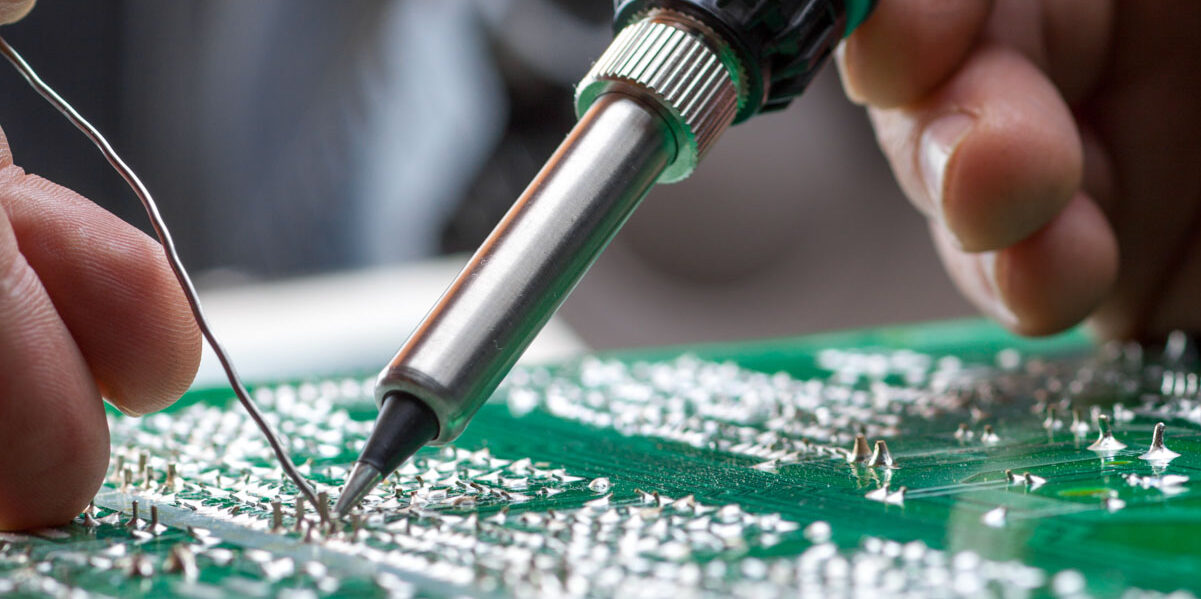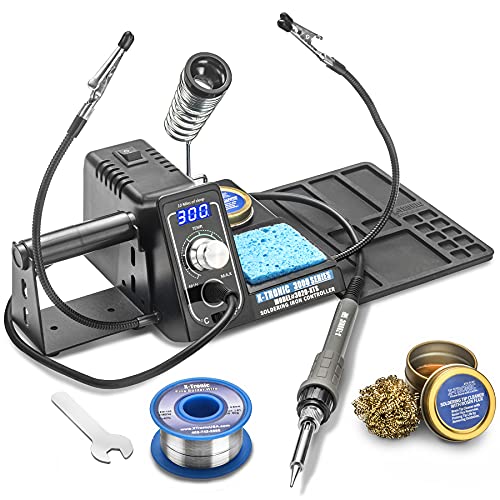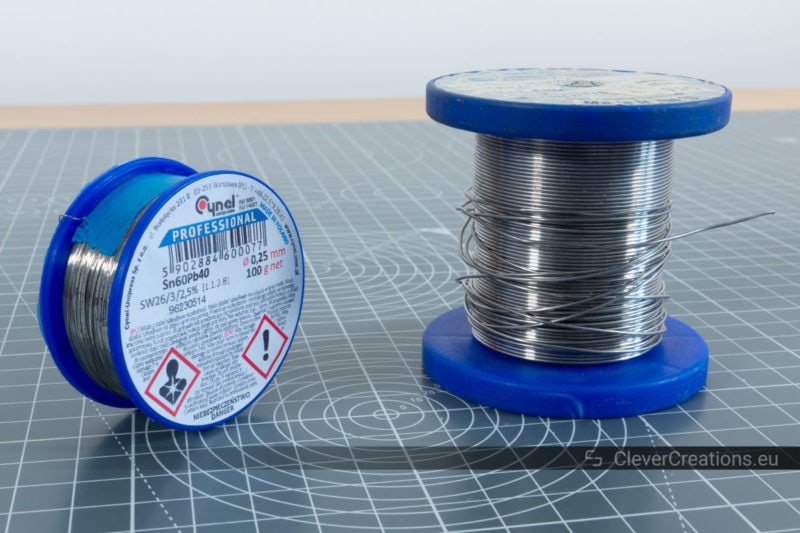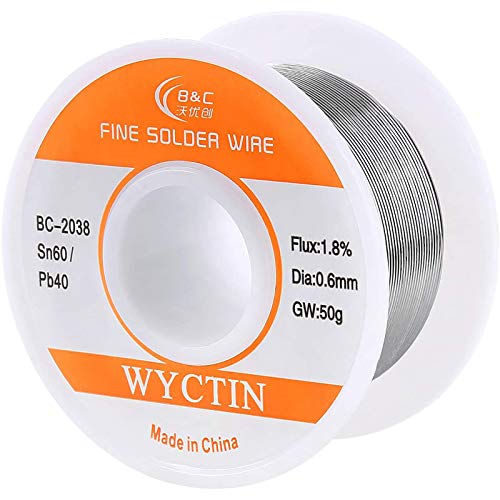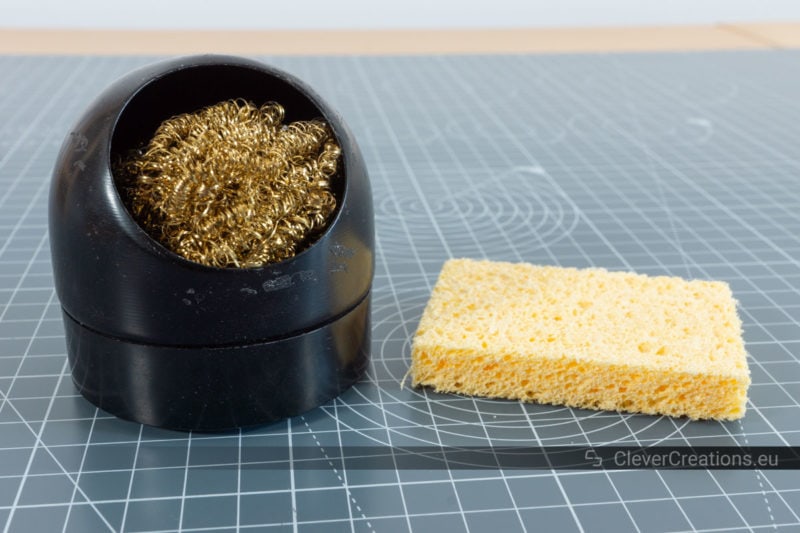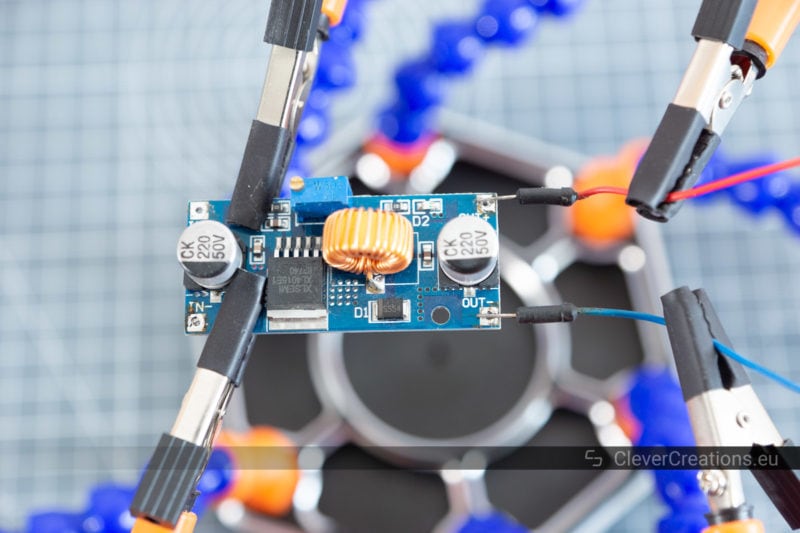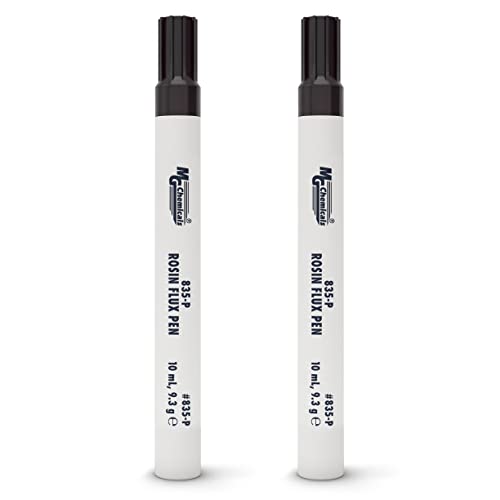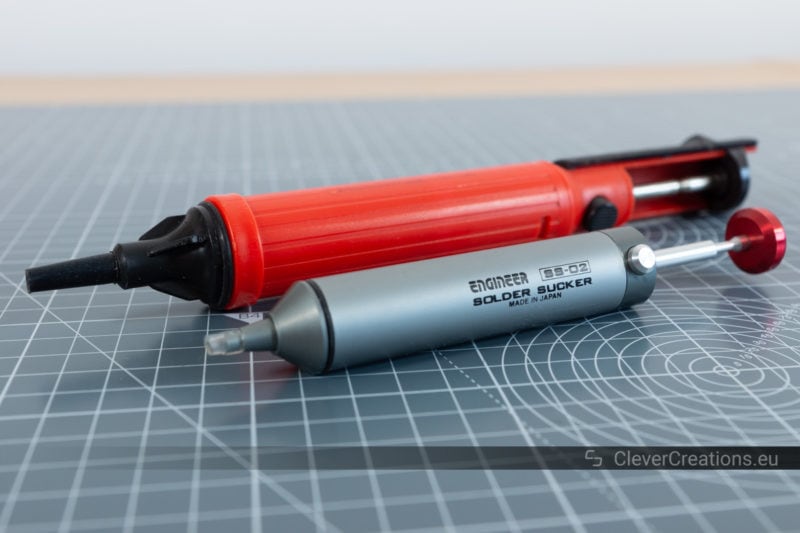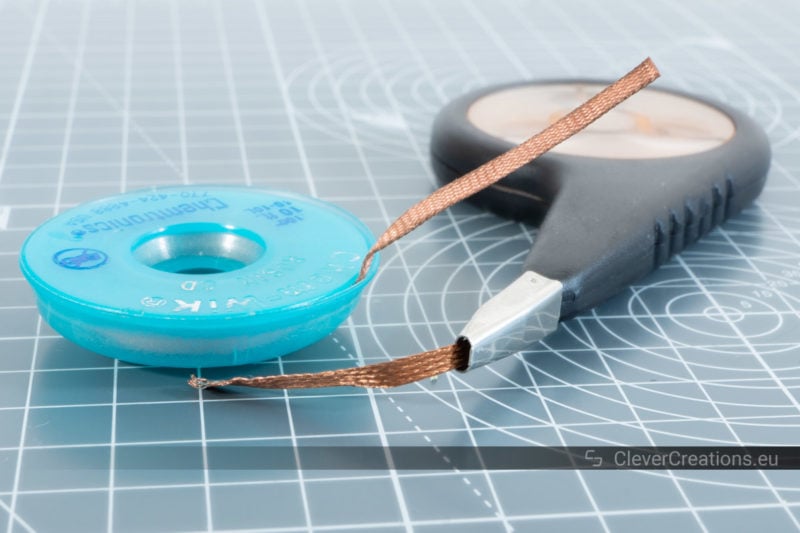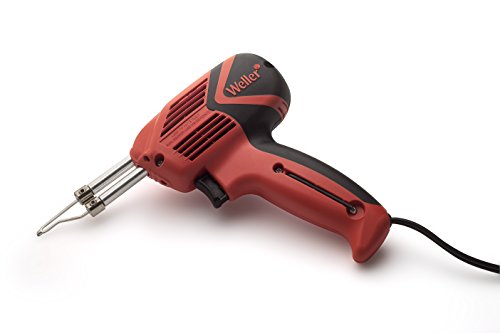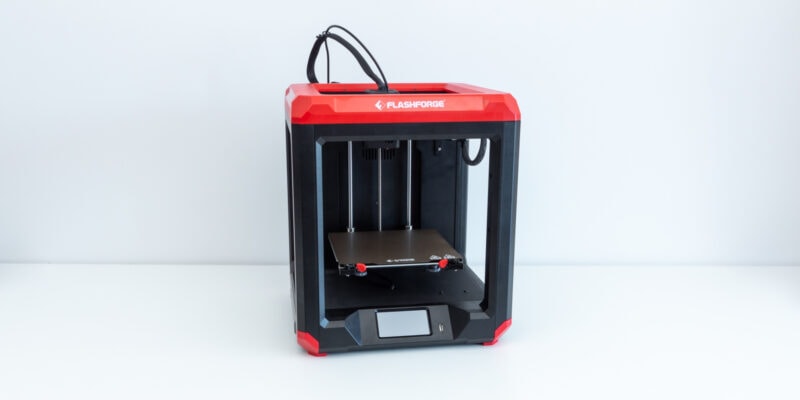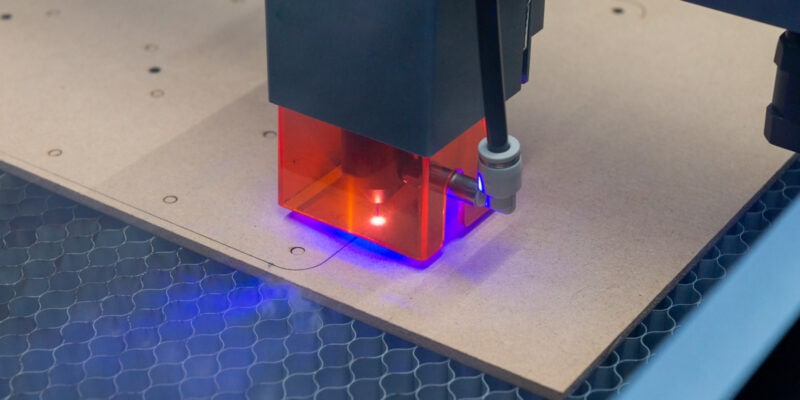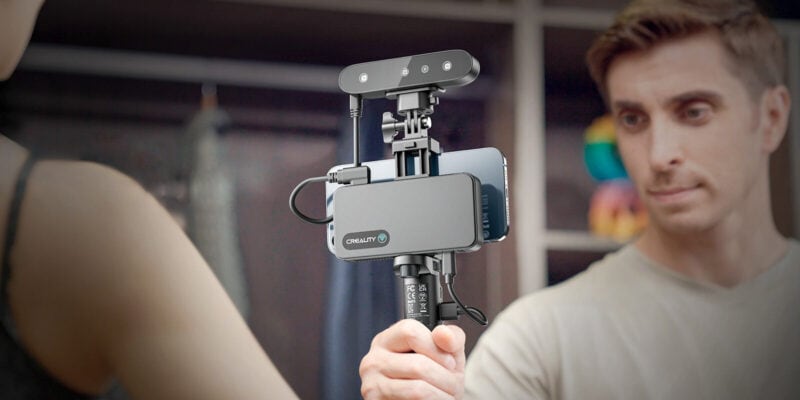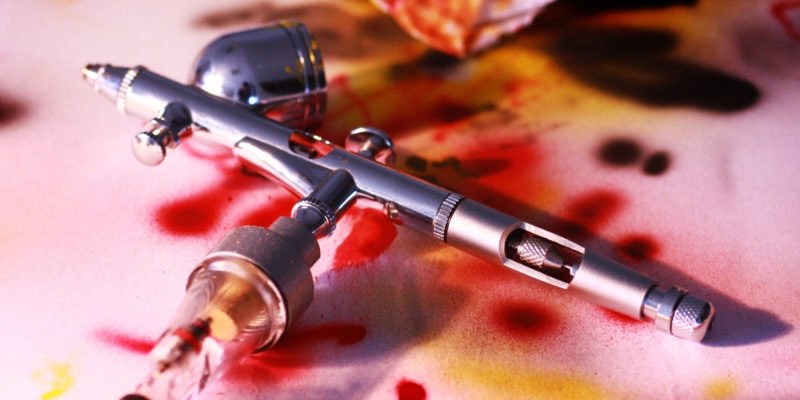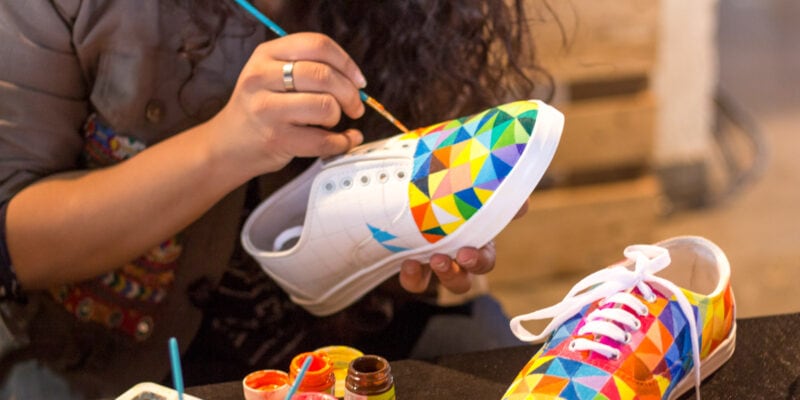Whether you are a hobbyist that only solders occasionally or a professional that does it a lot, a soldering iron is an indispensable tool. Its versatility allows you to build and repair electronics or circuit boards, create jewelry, soldering guitar wiring and all kinds of other projects. To get good soldering results in a short period of time however, it is important to use a quality soldering iron.
Picking the best soldering iron for your projects can be difficult. There are a lot of different ones available and this makes it hard to decide what soldering iron to buy. Many of them are similar, but not identical. It is important to pay attention to crucial differences in specifications, like wattage and temperature range, as well as differences in features, build quality and accessories.
To help you choose a soldering iron, I have compared the currently available soldering irons on the market, and have selected the ones that I think are the best choice for each type of user. I made this selection based on the products’ features, design, specifications, reviews and their manuals.
Further down the page I have added the things that you should keep in mind when buying a soldering iron. This can help you learn how to choose a soldering iron. I have also answered commonly asked questions on this topic. In short, this article has everything you need to know to find the perfect soldering iron for you.
Let’s dive in and review the best soldering irons currently available!
| Best Soldering Iron | Summary | Price | Best Offer |
|---|---|---|---|
| Hakko FX888D-23BY | Best overall | $105 | |
| JBC Tools CD-1BQF | Best high-end | $446 | |
| Weller SP40NKUS | Best on a budget | $33 | |
| Weller WLC100 | Best for beginners | $39 | |
| X-Tronic #3020-XTS | Best for hobbyists | $55 | |
| Weller BL60MP | Best cordless soldering iron | $91 | |
| LEXIVON LX-770 | Best butane powered | $39 | |
| YIHUA 862BD+ | Best with hot air gun | $115 | |
| LEXIVON LX-77 | Best for soldering jewelry | $40 | |
| Hakko FX601-02 | Best for stained glass | $93 |
What is a Soldering Iron?
A soldering iron is a handheld tool with a hot metal tip that is used for soldering. Its purpose is to provide heat to circuit board pads, wires and component leads. Once these areas are heated enough, you can apply solder to them to form a rigid and electrically conductive connection.
The ability to form strong and conductive bonds makes soldering irons versatile tools that can be used for many types of projects. For example, you can use a soldering iron for soldering electronics, making stained glass, creating jewelry, burning and engraving wood, and do the wiring on your guitar.
What is Solder?
Solder, or soldering tin, is the material used to join two (or more) pieces of metal together. It is an alloy of multiple metals and turns into a liquid when it reaches a certain temperature. It then forms a conductive bond between the pieces of metal, before it cools down again and solidifies.
Why Invest in a Good Soldering Iron?
When buying a soldering iron, you are faced with many choices. One of the most important choices is whether you are going to buy a quality unit that lasts you for years to come, or a cheaper one that needs to be replaced soon. Replacing a soldering iron might be necessary when it has inferior quality and breaks prematurely, or because it does not have the features that you need for new projects.
A good soldering iron has enough features to let you tackle many different soldering jobs, not just now, but also in the future. Quality units are built to last and you can expect to be able to use them for decades.
Using a quality soldering iron also gives you a better experience and better results. For example, you spend less time waiting for things to heat up and have less problems with cold joints caused by insufficient heat.
Best Soldering Irons in 2024
For a soldering iron to be labeled best overall, it must check a lot of boxes. For starters, it has to heat up fast and have an accurate, stable temperature. It needs to be reliable and built to last. Additionally, it must to be able to handle a wide range of soldering demands.
The Hakko FX888D is a soldering station that meets all those requirements. It heats up fast and has quick temperature recovery, so you can spend your time soldering instead of waiting. The temperature is accurate, so it won’t accidentally overheat and damage components or boards. The build quality is excellent as well, as is typical with Japanese tools.
This soldering station comes with a digital display that you can use to easily set and read the iron’s temperature. Both the main unit and the iron holder are weighted, so it is less likely that the hot iron tips over and causes damage. It uses T18 series tips that have great conductivity and a long lifespan. These tips are readily available and are acceptably priced.
If you are looking to invest in a soldering iron that gives you outstanding soldering results for years, this is the one to go for. Buy it now, enjoy it in the decades to come.
Standout Features
- Digital temperature readout
- Stable base and iron holder
- Programmable presets
Technical Details |
|
|---|---|
| Type | Digital soldering station |
| Temperature Range | 120-899°F / 50-480°C |
| Wattage | 70 Watts |
What We Like
- Heats up fast
- Reliable
- Wide temperature operating range
Could Be Better
- Unintuitive interface
If soldering is your bread and butter (or part of it), you need something that can not only help you solder a wide range of projects, but it also needs to be capable of doing this day in, day out, without breaking down or decreasing in performance. It needs to be very accurate, but also have enough power to deal with large ground planes or components with a large thermal mass.
The JBC Tools CD-1BQF (or the JBC CD-2BQF if you are located in the EU) soldering station offers you just that. It has everything a professional needs for flawless results each time. It gives you excellent value, as it competes with soldering irons that cost up to thousands of dollars. When it comes to soldering productivity and efficiency, this is the ultimate tool.
The CD-BQF comes with a hibernation & sleep system that significantly extends the life of the tips. When placing the iron in the holder, the tip automatically decreases in temperature. After a while, the unit goes into hibernation mode where the tip cools down further. When you need to solder again however, the tip is back up to temperature in under 2 seconds. No time wasted.
The cartridge extractor on the station lets you switch tips while the iron is hot. This allows you to switch tips in no-time and continue working without unnecessary interruptions.
Standout Features
- Heats up under 2 seconds
- Cartridge extractor lets you switch soldering tips while iron is on
- More than 150(!) different available tips
Technical Details |
|
|---|---|
| Type | Digital soldering station |
| Temperature Range | 190-840ºF / 90-450ºC |
| Wattage | 130W |
What We Like
- Flawless results each time
- Excellent ESD safety
- 130W of peak power
Could Be Better
- Tips are on the pricy side
On the other end of the spectrum are the budget soldering irons. Fortunately, when you don’t have a lot to spend it is still possible to buy a good iron. It won’t come with many features, but will still do the job. Ideal for when you rarely solder or for when you only need to do a single project, like soldering the wiring on a guitar.
The Weller SP40NKUS 40W is a soldering pencil that meets these criteria. Despite its low price, it still has a comfortable grip and comes with extra replaceable tips. It even has LEDs that shine on the object being soldered, which is not something you see on many other irons. With 40 Watts of power it heats up relatively fast, so even when on a budget there is no need to waste your valuable time.
Despite its low price, you still get a good soldering iron with two extra tips. With its 7 years of warranty you can be confident that you won’t be without a soldering iron if the iron happens to break.
Standout Features
- LEDs that light up your workpiece
- 2 spare tips included
- 7 (!) year warranty
Technical Details |
|
|---|---|
| Type | Soldering pencil |
| Temperature Range | Up to 900ºF / 482ºC (non-adjustable) |
| Wattage | 40 Watts |
What We Like
- Comfortable to use
- Heats up fast
- Gets the job done
Could Be Better
- No temperature control
When you are just starting out with soldering, you don’t need anything fancy. But it is still important that the iron you use is consistent and works well. A good tool is key when learning a new skill like soldering. That way you are not held back in developing your abilities. A variable temperature feature is useful too, so you don’t need to immediately upgrade the iron when you solder more advanced work.
As a beginner, the Weller WLC100 40-Watt is an excellent soldering iron with chisel tip for beginners. Without having to spend a lot, it still lets you solder with consistent results while you learn the ins and outs of soldering.
This iron has a cushioned foam grip, so your hand won’t get tired as fast while you are getting used to soldering. It does not take up a lot of your desk space, but despite that it still comes with a stand to store the iron and a cleaning sponge to help extend the life of the tip.
It also comes with a knob to modify the power (from 5 to 40 Watts). This gives you the exact power you need for the project at hand.
Standout Features
- Adjustable power
- Interchangeable tips
- Comfortable, lightweight iron
Technical Details |
|
|---|---|
| Type | Analog soldering station |
| Temperature Range | Up to 900°F / 482°C |
| Wattage | 40 Watts |
What We Like
- Excellent value
- Takes up little space
- Comfortable to use
Could Be Better
- No temperature display
If you are a hobbyist that regularly solders wiring or electronics, you can benefit from a soldering station that has extra features and accessories. For example, a set of helping hands to hold wires or a PCB, and a solder spool holder so that you don’t have to manually unroll a spool while your hands are occupied.
The X-Tronic Model #3020-XTS comes with a bunch of built-in accessories that make your soldering life a lot easier. Aside from the ones mentioned above, it also comes with a digital read-out display to easily check the temperature of the tip, a tip cleaner and even an auto-sleep function for when the iron accidentally gets left on.
Standout Features
- Built-in helping hands
- Automatic sleep mode
- Spool holder
Technical Details |
|
|---|---|
| Type | Digital soldering station |
| Temperature Range | 392-896°F / 200-480°C |
| Wattage | 75 W (60 W for the iron) |
What We Like
- Heats up fast
- Easy to use interface
- Digital temperature display
Could Be Better
- Questionable build quality
- No 220V version
If you are spending a lot of time off the grid or in the field, you can run into situations where you need to solder without access to electricity. In such situations you need a cordless soldering iron to solder. They come in two flavors, battery powered and fuel powered.
For the best battery powered soldering iron, look no further than the Weller BL60MP. It is compact enough to take with you wherever you go, but still has enough battery power to solder for 45 minutes or to form 1100 solder joints. This gives you more than enough time to solder a couple of quick projects.
When the battery does run out, you can use the included charging station to charge it up within a few hours. Despite running off of batteries, this cordless iron is able to reach the same temperatures as corded irons.
Whether you need to quickly fix wiring while on the road, solder emergency repairs on your RC car or do any soldering while off the grid, this compact unit has got you covered.
Standout Features
- Charging station included
- LED light
- 7 years of warranty
Technical Details |
|
|---|---|
| Type | Cordless soldering iron |
| Temperature Range | Up to 950ºF / 510ºC |
| Wattage | 12 Watts |
What We Like
- Temperature control
- Can reach high temperatures
- Heats up in around 35 seconds
Could Be Better
- No charge indicator on the unit itself
If you are looking for a butane powered iron instead, you are well served by the LEXIVON LX-770. It has a large tank that lasts up to 75 minutes and that takes only 10 seconds to refill. So if you need to solder a lot without access to mains power, this is a great option. It also comes with a temperature adjustment setting and a variety of soldering tips in a practical carrying case.
Not only can you use this device to solder, but it also doubles (or triples) as a hot knife and blowtorch. The kit comes with a multitude of attachments that make it a versatile tool for use in many of your projects.
Standout Features
- Practical carrying case
- Large tank
- Useful attachments
Technical Details |
|
|---|---|
| Type | Butane cordless soldering iron |
| Temperature Range | Up to 1100°F / 593°C with soldering tip Up to 2400 °F / 1315°C without tip |
| Wattage | 125 W equivalent |
What We Like
- Precise control over the flame
- Easy to refill
- Safe to use
Could Be Better
- Only works with high quality (3+ times refined) butane
When you branch out in your soldering and start working with SMD components, it is useful to have access to a hot air gun. These can be purchased as a separate tool, but it is also possible to buy a soldering station with a hot air gun attachment. This allows you to do ‘regular’ soldering along with the occasional SMD rework, all with a single device.
The YIHUA 862BD+ hot air rework station is an excellent option for soldering both through-hole components and SMD/SMT parts. It has a regular soldering iron as well as a hot air gun, and comes with basically everything else you need to get started. For example, included with the station are multiple hot air gun nozzles to direct air, tweezers to handle small components and a desoldering pump to remove solder.
In short, this is a great unit if you want to move on from a regular soldering iron and expand the types of components you can work on.
Standout Features
- Independent control over heat gun and soldering iron
- Automatic shut off function
- Comes with many useful soldering accessories
Technical Details |
|
|---|---|
| Type | Soldering station with heat gun |
| Temperature Range | Iron: 392-896°F / 200-480°C Hot air gun: 212-896°F / 100-480°C |
| Wattage | Iron: 75 W Hot air gun: 500 W |
What We Like
- Relatively accurate temperatures
- Small footprint
- Heats up fast
Could Be Better
- Poorly translated manual
When making or repairing jewelry, it is inevitable that at some point you find yourself having to solder. For this you need a soldering tool that can reach high temperatures. Silver solder, for example, has a melting point of somewhere between 1250-1500°F / 650-815°C. Regular irons only get up to about 900°F / 480°C, so for jewelry you need to go a step up and work with a soldering torch.
So if you are set on creating your own jewelry, it is important to use a tool with an open flame that gets hot enough to melt silver, gold or other fancy solders. The LEXIVON LX-771 is an excellent starter butane torch that lets you do just that.
This torch is designed for easy use. It has a flame lock function that locks the torch while it is on. That way, you do not need to keep the trigger pressed for long periods of time. It also comes with a removable, stable base that lets you rest the torch on a surface without having to worry that it tips over.
Aside from jewelry, you can also use this torch for many other projects around the house or workshop. For example, for welding copper piping or even to make crème brulee in the kitchen!
Standout Features
- Attachable base stand for hands-free operation
- Flame lock function
- Large tank
Technical Details |
|
|---|---|
| Type | Soldering torch |
| Temperature Range | Up to 2400 °F / 1315°C |
| Wattage | 125 W equivalent |
What We Like
- Stable base
- Easy to use hands-free
- Practical attachments
Could Be Better
- Needs high quality (3+ times refined) butane
It doesn’t matter if you are just getting started with stained glass or if you are a seasoned pro, either way you will need a powerful soldering iron with good temperature control. One of the most popular soldering irons for stained glass is the Hakko FX601. It is easy to use and helps you create nice looking solder seams.
This soldering iron comes with excellent temperature recovery, so you don’t need to wait long for it to get back up to temperature after soldering. It comes with a temperature control knob on the handpiece. This allows you to adjust the temperature to help get clean and smooth soldering results.
Standout Features
- Fast temperature recovery
- Provides stable temperatures
- Comfortable handpiece
Technical Details |
|
|---|---|
| Type | Soldering pencil |
| Temperature Range | 464-1004°F / 240-540°C |
| Wattage | 67 W ceramic heating element |
What We Like
- Powerful ceramic heating element
- Consistent temperatures
- Replacement parts available
Could Be Better
- Stiff and heavy power cable
- Temperature knob hard to grip
Buyer’s Guide – What to Look for When Buying a Soldering Iron
When trying to find the best soldering iron for your needs, it is crucial to keep several things in mind. There is a lot of variation between soldering irons and not all of them are a good choice for your projects. For example, it is essential for the soldering iron to have the right amount of power and to provide the right temperature range.
Let’s take a closer look at the factors that are important when deciding which soldering iron to buy.
Power / Wattage
A soldering iron’s power output is one of its most important features. It is measured in Watts and also gets referred to as its wattage. Enough power allows an iron to heat up fast and to easily maintain its temperature while soldering. With an underpowered soldering iron you will have a difficult time getting good results, and you are more likely to end up with messy solder joints.
Keep in mind that a higher wattage does not equal a higher temperature. It only affects how quickly a soldering iron heats up. This does not only come in to play when initially heating up the iron, but also during soldering. Each time you solder a joint, the iron loses heat and drops in temperature. The wattage affects how fast it recovers that temperature.
Which Wattage is Best?
Typical soldering irons come with 20 to 80W of power. When buying an iron, you don’t necessarily need to go with the highest wattage. Less power might be okay for you if you don’t plan on soldering components with a high thermal mass. Instead you can save money buying something less powerful.
Soldering irons can be classified in several rough categories based on their power:
- < 30 Watts. Soldering irons with less than 30W of power are not something I would ever recommend. They are underpowered, causing you to have to wait a long time for it to get up to temperature. During the soldering of a joint, they do not provide enough heat to maintain temperature.
- 30-50 Watts. These irons have enough power to heat up fast and to remain at temperature. They are excellent for basic soldering jobs and you can find a lot of good value options in his range.
- 50-70 Watts. The most common available wattage in this range is 60W. This is a great choice for most soldering jobs. You can find a lot of reliable soldering irons in this range.
- 70 Watts and higher. Soldering irons with 70W or more are suited for bigger solder jobs, like soldering lower gauge (=thicker) wires. Unless you are a professional that has to solder real heavy-duty stuff, this is likely more than enough for your needs.
Because the lower Watt soldering irons are pretty much useless, I have made sure to only add ones with 40W or more in the recommendations of this article.
Temperature Control and Range
Temperature control on a soldering iron gives you the ability to adjust the temperature of the tip. Not all soldering jobs require the same temperature. For some things, like lead-free solder or heat-sensitive components, you need to work within a different temperature range in order to get good results.
In order to use your soldering iron for a wide variety of soldering jobs, the best choice is to buy one that comes with temperature control. It is also important that the temperature settings cover a wide enough range however.
Adjustable soldering irons and stations typically come with a temperature range of 392-896 °F(200-480 °C). This is wide enough for most applications and is sufficient to work with lead-free solder.
Temperature Accuracy
Aside from temperature control over a wide enough temperature range, it is also important that the temperature of the soldering iron tip is accurate. You don’t want to set your soldering iron or station to a certain temperature, only to find that the temperature of the tip is way off. This can lead to bad solder joints and even damage to components through overheating.
Buying a soldering iron with good temperature accuracy gives you the confidence that the set temperature is equal to the actual temperature of the tip. In general, higher quality units from reputable brands tend to be more accurate than cheaper off-brand alternatives.
Digital vs Analog
When researching which soldering iron or station to buy, you might notice that some of them are labeled as analog, and others as digital. Their main difference is in the way they control the temperature.
Analog soldering irons are the simplest of the two options. They have a knob to control the output temperature and that’s about it. There are no advanced electronics that ensure accurate temperature, and there is also no display that shows the set temperature of the iron.
Digital soldering irons (these are usually stations) are more advanced than their analog counterpart. They are also more accurate and have narrower temperature tolerances.
Digital soldering stations typically come with a display that shows the temperature setting of the iron, sometimes with the actual temperature next to it. In terms of controls they offer either a rotary knob or physical buttons. A knob is preferred, because it only takes a single operation to fully adjust the temperature. When working with buttons it can sometimes take multiple key presses to adjust a setting.
The downside of digital irons is that they are more expensive.
Soldering Iron Type
Soldering irons come in several types which can be a bit confusing. Some examples of types are solder pencils, soldering stations, adjustable soldering irons, cordless irons and soldering guns. They differ in various ways, most notably in their output temperature, power and portability.
For most users I recommend a soldering station. For more information I refer you to the relevant section on soldering iron types further down the page. It has details on each type, along with benefits & drawbacks, best use cases and product recommendations.
ESD Safe vs Non-ESD Safe
Soldering irons are either ESD safe or non-ESD safe. ESD stands for electrostatic discharge. It is a rapid transfer of charge that takes place when two objects with different potential come close to each other. Because electrostatic discharge typically has a high voltage and a miniscule current, it does not pose harm to humans. Electronic components, however, are often sensitive to ESD and can get damaged by it.
If a soldering iron or station is considered ESD safe, no static charge gets generated on the iron or station. This typically means that the tip of the iron is earthed. This is done with a path from the tip, through the entire device, to earth.
Earthing is what prevents a voltage from building up on the tip. This is what happens with insulated soldering iron tips and needs to be avoided.
For a soldering station to be considered truly ESD safe, a lot more needs to be done than earthing the tip. All external surfaces of the station (main unit, wire insulation and the grip of the iron) have to be made of a static dissipative material that is connected to ground. This eliminates any risk of ESD. For example, if you happen to touch a circuit board with the cable of the soldering iron.
Unfortunately, this extra ESD safety comes with a significant additional cost. As a consequence, fully ESD safe soldering stations are mostly used in industries that deal with ESD certifications.
If you are a hobbyist, you will be okay if you take basic precautions against ESD.
- Make sure to use a soldering iron or station that has a grounded tip.
- Don’t let the electronics you are working on come in contact with objects that can be electrostatically charged.
- Use an ESD mat with ESD wrist strap, and connect them both to ground.
Should You Get an ESD Safe or Non-ESD Safe Iron?
In conclusion, always get an ESD safe soldering iron or station that at the very least has its tip grounded. There is no reason to ever go with a non-ESD safe option.
Ergonomics
A soldering iron needs to be easy to hold and maneuver around. Working for a long time with an unwieldy hunk of metal and plastic is unpleasant. You don’t want to end up with fatigue and cramps in your hand. In addition, the precision involved in soldering means that you want something that is easy to position and aim.
For maximum comfort, you want to have a lightweight iron with a thin silhouette and ideally some kind of rubber/silicone grip. Other than that, the grip should also not get noticeably hot to the touch.
Soldering stations are typically better for this than soldering irons. They have all their electronics in the main unit that rests on your desk. This makes the iron itself a lot lighter.
Standalone soldering irons need to contain everything in the handheld unit themselves. This makes them larger, heavier and more unpleasant to work with.
Soldering Tips
Soldering tips are located at the end of a soldering iron and do the actual work. They are hot and responsible for transferring that thermal energy to the object being soldered. They are typically made out of copper, for its heat transfer properties, with an iron coating for durability.
Even though soldering iron tips are durable, they don’t last forever. Over time they oxidize and wear down. This makes it important to buy a soldering iron with replaceable tips. It would be bad to have to replace an entire soldering iron just because the tip wears out.
Tip Types and Shapes
Soldering tips come in different shapes and sizes. The shape of a tip affects how it distributes solder. This causes differently shaped tips to be suited for different soldering jobs. Some examples of tip shapes are chisel, conical, hoof, pyramid, mini-spoon and mini-wave.
Chisel and conical tips are the most common tips in use. Chisel tips are an excellent option for beginners. They have a large flat surface that makes them good at transferring heat and easy to hold in place. They are ideal for soldering through-hole components.
Conical tips are harder to work with than chisel tips, but give you a lot more precision. For that reason they are more suited for the soldering of delicate components, like small SMD parts. Hoof tips are a great choice for this as well.

What to Pay Attention to When It Comes to Soldering Tips
- Make sure that the soldering iron you intend to buy has replaceable tips, and those tips are affordable and readily available. You don’t want to spend a fortune on tips during the lifespan of the soldering iron.
Sometimes you can buy compatible tips from other manufacturers. This gives you extra options to choose from. - Copper tips with an iron coating perform better than all-iron soldering tips. All-iron tips are cheaper, but do not conduct heat as well as copper tips.
- It is great if a soldering iron comes with various additional tips. This gives you more flexibility when soldering and saves you from having to buy individual extra tips later. These are usually more expensive when bought separately, compared to when they come included with the iron or station.
Price
Another factor to consider when selecting a soldering iron is the price. You can spend as low as $10 for a cheap iron, or hundreds of dollars for a professional-grade soldering station. Luckily, you don’t need to spend a fortune to get good results. A mid-range model is often more than enough.
A quality soldering iron is likely to last for a long time. Given that it is a long-term investment, it is a good idea to make sure that it has enough features for your future needs. This usually already eliminates the cheapest options.
Higher-end soldering stations are good for certain specialized work, but don’t do anything special when it comes to your basic and intermediate soldering. So it is better to save some money there and go with a good mid-range model.
Brand
Just like with anything you buy, buying soldering equipment from a reputable brand gets you a better quality product, better customer service, longer warranty and better return policies. This means spending a bit more money up front and is, in my experience, worth it to avoid future hassle with products that break prematurely or do not give you good results. Spend a bit more, save time and frustration.
Soldering Accessories
While a well-performing soldering iron is the most important thing when it comes to soldering, it helps to have some soldering accessories to get the best results. For example, you need something to clean and tin the tip, and if you apply too much solder somewhere, you need to be able to remove it.
Oftentimes, the soldering iron that you buy already comes with one or more accessories. This is something to keep an eye on when you are picking a soldering iron, because it means you don’t have to buy these later.
Let’s take a look at commonly used soldering accessories, and which ones are necessary and which ones are optional.
Necessary Accessories for Soldering
Soldering Tin
You can’t solder without solder. Solder is a metal alloy that you melt in order to create a bond between metal parts. It often contains flux in its core, which makes soldering easier. When buying solder, you can choose between lead and lead-free solder. Both are available in various thicknesses.
Leaded vs Lead-Free Solder
Leaded solder is a mixture of tin and lead. For a long time it was the most used solder in electronics manufacturing and rework. In recent times however, health and environmental concerns about lead have led to the ban of lead (you might have to read that twice!) in newly produced electronics in the EU. As a consequence, leaded solder is used less and less, even though it is still commonplace in the US.
The most commonly used leaded solder is 60/40 rosin core solder. It consists of 60% tin and 40% lead and is great for both beginners and professionals alike. It is cheap, easy to work with and creates quality solder joints.
Lead-free solder is harder to work with than leaded solder. It requires a higher temperature to melt and comes with a higher risk of tin whiskers. These are thin filaments of metal that can grow out of certain metals. Eventually they can form unwanted bridges between solder joints and cause electrical failure.
On the plus side, lead-free solder is better for the environment and safer to work with.
Two popular lead-free solders are 99.3Sn 0.7Cu and 97Sn 0.3Ag 0.7Cu rosin-core solders. They mainly consist out of tin (Sn), copper (Cu) and sometimes silver (Ag).
What Thickness of Solder to Get?
When soldering, you always want to match the diameter of the solder to the joints that you are soldering. If you want to fill large joints in quickly, then a thicker solder like .062″ / 1.5mm is ideal. For very small joints however, you are better off with .02″ / 0.5mm.
Basically, make sure that you have a couple of different sizes of your favorite solder at hand, and you’ll always be ready to go.
Stand
Technically you can solder without a stand, but that would be dangerous so I included it with the necessary accessories. Soldering irons get very hot (up to 480°C/896°F) and it is important to keep them in a secure place when not in use. That way you won’t accidentally burn yourself or objects around you.
A soldering iron stand is made for storing your iron when you are not actively soldering. That way you know where it is at all times. Soldering stations nearly always have a stand included, but if you buy a loose handheld iron, chances are that you need to buy a stand separately. They don’t cost much and are essential.
Sponge
Soldering iron tips continually oxidize, especially at higher temperatures but also at room temperature. To get the best soldering results it is necessary to remove the black oxidation layer and keep the soldering tip clean. This is typically done with a sponge. Aside from improving the soldering itself, it also extends the lifespan of the tip.
Typically two types of sponges are used for this, conventional sponges and brass sponges. Conventional sponges are used wet, which temporary drops the temperature of the tip. This causes the tip to contract and expand, eventually shortening its lifespan.
Brass sponges are used dry and do not come with any of these negative effects. This makes them the preferred option.
Optional Accessories for Soldering
Helping Hands
A helping hands or third hand tool is a device that holds things for you. It comes with two or more arms with alligator clips on the end. Sometimes the arms come with extra attachments, such as a light or a magnifying glass that lets you see your soldering up close.
Helping hands make soldering a lot easier. For example, aligning two thin wires and soldering them at the same time is tricky to do with only two human hands.
A third hand tool is not strictly necessary for soldering, but they are very useful. Aside for soldering, you can use them in other situations where things need to be held in place as well.
When buying a helping hands tool, it is important to pick one that comes with a stable base and that has rigid but easily adjustable arms. Magnification and especially light are useful additions.
Flux
While most soldering tin already comes with flux in its core, there are times when you need to add more. For example, when you are doing rework on a board with lead-free solder, and you need to improve its flow. In these cases, it is useful to have the ability to add extra flux.
The two most commonly used fluxes are rosin flux and no-clean flux. Rosin flux works better, but needs to be cleaned from the circuit board afterwards. No-clean flux works a bit less well, but can be left on the PCB after soldering and does not require the extra cleaning step. If you are just starting out, no-clean flux is a good option to start with.
There are many different ways to apply flux. You can use a flux pen, a syringe with flux, and you can even apply it with a brush from a container. Flux pens and syringes are great for precisely adding flux where you need it.
ESD Safe Soldering Mat
In order to protect your workpieces from electrostatic discharge that can build up in your work area, it is helpful to get one or more ESD protection devices. One way of doing this is by using an ESD safe soldering mat.
Aside from protecting the electronics you work on from any unwanted static discharges, it also has the benefit of protecting your work surface from splashes of solder or any other things that might damage it.
Antistatic Strap
Another way to protect the electronics that you are working on against ESD is with an antistatic wrist strap. One end goes around your wrist, and the other end connects to a ground point. By grounding you, it prevents any static charge jumping from you to the workpiece.
Solder Fume Extractor
Soldering fumes pose a serious hazard to our health. They are released when flux is heated past its boiling point and have significant negative effects when they come in contact with our eyes and lungs. Filtering the fumes with a solder fume extractor is the best way to remove the harmful chemicals from the air.
While it is also possible to use a simple fan to blow the fumes away, or to work in a naturally ventilated work area, this still leaves the hazardous particles floating in the air somewhere. It is best to filter them out as much as possible.
When only soldering occasionally, most people do not use a fume extractor. But to make sure that you don’t experience any negative long-term health effects when working on your hobbies, it is best to use one.
Desoldering Tools
When soldering, no matter if you are a beginner or a seasoned professional, it is inevitable that you occasionally lay down too much solder. In such cases, it is useful to have access to one or more desoldering tools. These tools let you easily remove excess solder from the solder joints that you are working on.
The two most commonly used desoldering tools are desoldering pumps (also known as solder suckers) and desoldering braid (also known as desoldering wick or solder wick). Both are good options. When you need to remove large volumes of solder at once, a desoldering pump is the best option. For the finer cleanup you get better results with desoldering braid.
What Types of Soldering Irons are There?
Not only do soldering irons come with different features and specifications, they can also be subdivided in different categories. For example, there are soldering pencils, soldering stations, soldering guns and other (sub)types that are used to categorize soldering irons. Let’s take a closer look at them and go over the pros and cons of each.
Solder Pencils
Solder pencils are the simplest type of soldering iron available. Not coincidentally, they are also the cheapest. They are often used by beginners who are just starting out, and it does not take long for them to be upgraded to a soldering iron with more features.
They are called solder pencils because of their pencil-like ergonomics. Aside from transferring heat to the metal tip, they do not do much else. There is usually no adjustable temperature control or a temperature read-out, so you are limited in the types of projects that you can use them for.
Pros
- Inexpensive
Cons
- No temperature control
- Limited power
- No stand
Best Used for
Beginners, very simple soldering jobs.
Recommended Product
Adjustable Soldering Irons
Adjustable, or temperature controlled soldering irons are a step up from solder pencils. Whereas pencils reach a temperature based on the balance between input power and environment cooling, adjustable soldering irons are able to control their temperature independently. They do this by increasing heating power when its temperature sensor indicates the temperature is getting too low.
The knob for adjusting the temperature is usually found on the handle of the soldering iron. An adjustable temperature lets you work with solders that have non-standard melting temperatures (like lead-free or bismuth solder), or you can use it to lower the temperature when you are working with delicate components.
Another benefit of a temperature-controlled soldering iron is that when the tip reaches its set temperature, the heating element turns off. This prevents the tip from overheating and lets it perform better and last longer.
Because the entire unit is handheld, it needs to be compact (unlike a soldering station). The downside of this is that it can only fit a small power supply with limited power. As a consequence, it can take a while for to get up to temperature and it is harder for it to remain there while soldering.
Pros
- Adjustable temperature
Cons
- Take a while to get up to temperature
- Limited power
- No stand
Best Used for
Anyone who wants to solder with temperature control, but does not have enough space for a soldering station.
Recommended Product
Soldering Stations
A soldering station is a device with multiple purposes. It consists of a main unit with one or more soldering tools connected to it. The most commonly attached tool is a soldering iron, but it can also come with additional tools like desoldering tweezers, a hot air gun or even an infrared heater.
Its main unit has the temperature controls and often a temperature readout. It also contains the power supply, which can be a lot bigger and thus more powerful than in handheld soldering irons. As a result, the soldering iron can reach higher temperatures, get up to speed faster and heat larger objects because of its increased heat output.
Because the control electronics, power supply and fuses are all located in the main unit, the soldering iron itself is a lot lighter and easier to handle.
A soldering station often comes with holders and stands for its attachments, so that you don’t need to rest the soldering iron or hot air gun on your desk surface. This makes it a lot safer than handheld irons that often come without a stand. Similarly, soldering stations often come with auto-sleep and auto shutoff functions. These set the tip to a lower temperature or turn the heating off completely to increase its life.
Pros
- Precise temperature control
- Plenty of power
- Built-in stand
Cons
- More expensive than simple handheld soldering irons.
Best Used for
Anyone who regularly solders and needs precise temperature control, good ergonomics, and/or enough power to solder larger components.
Recommended Product
Cordless Soldering Irons
Cordless soldering irons (also known as portable or wireless soldering irons) are practical if you need to solder in tight places that are difficult to reach, or in locations where you do not have access to mains power. You might want to use these if you are a mechanic, are on the go a lot, or if you need to solder while living off the grid.
Portable soldering irons generate heat in one of two possible ways, either through the use of battery power, or through combusting fuel.
Electric Cordless Soldering Irons
Electric cordless soldering irons are powered by batteries. Often this is a lithium-ion battery because of its relatively (compared to other batteries) high energy density. This energy density is unfortunately still quite limited, and as a result these irons do not last very long.
Another downside of this type of soldering iron is that they often do not heat up that fast, meaning that you spend valuable battery life waiting for the tip to reach its set temperature.
Electric portable irons also have a maximum temperature that is typically lower than what a mains powered soldering iron can provide. So you are limited in what you can solder with it.
Still, if you are looking for a portable, small soldering iron that is suited for simple jobs, it is a good option.
Pros
- Portable
- Practical for hard to reach areas
- Safe
Cons
- Limited battery life
- Don’t get as hot as mains powered soldering irons
Best Used for
Soldering small stuff while on the go or when soldering without access to mains power.
Recommended Product
Butane Powered Soldering Irons
Butane powered soldering irons use butane gas to generate heat. Butane has a high energy density which allows the tip to get very hot. In addition, butane powered irons tend to last longer on a full tank than electric cordless irons and are easy to refill.
Just like their electric counterpart, butane powered irons are not perfect either. Their main issue is that it is impossible to precisely control their temperature. This can lead you to accidentally overheat and damage components and/or boards.
And then there is the matter of the open flame in the device. When working in areas with flammable vapors, it can cause these vapors to ignite, potentially leading to serious injury. Similarly, a cheap, low quality butane torch can be a danger just on its own.
Needless to say, potential injury is something you want to avoid when working on your projects. So if you intend to use a butane powered iron, get a high quality one, use it in well-ventilated areas and follow its instructions.
Pros
- Portable
- High temperatures
- Easy to refill
Cons
- Temperature hard to precisely control
- Potentially dangerous
Best Used for
Soldering components with a high thermal mass on the go or when soldering without access to mains power.
Recommended Product
Soldering Guns
A soldering gun is a pistol-shaped (hence the gun) electrical tool that is used for soldering. It has a high power output (usually 100 to 240 Watts) and heats up and cools down real fast. Unlike other soldering irons, it only turns on when needed after pressing its trigger.
Soldering guns contain a transformer that reduces AC power to a lower voltage. When the trigger is pressed, a high current passes through the soldering tip which in turn quickly heats up. This makes it a practical tool for situations where you only need to solder occasionally. Because it cools down rapidly after releasing the trigger, there is no need to place the device in a stand while it is not being used.
Soldering guns do come with downsides. They do not have any temperature regulation, so using them on electronic components or PCBs can easily lead to overheating and damage. On releasing the trigger, they also generate an electromagnetic spike that can damage electrostatic-sensitive components.
Pros
- Lots of power
- Heats up fast
- Cools down fast
- Does not need a stand
Cons
- No temperature regulation; easy to overheat things.
- Not suited for soldering ESD-sensitive components.
Best Used for
High-power soldering of non-electronic components, like large diameter wires and cables, stained glass work or sheet metal work.
Recommended Product
Soldering Torches
Soldering torches don’t really count as soldering irons, but I have included them nonetheless. They are torches that emit a powerful flame. Just like gas-fueled cordless soldering irons, they are powered by butane gas. And like soldering guns, their strength comes from high heat output.
This high heat output makes them an excellent tool for soldering metal (copper, bronze, brass) pipes and fittings. But if you are looking to solder electronics with them, you are out of luck. Aside from being way too powerful, the heat of the open flame is also hard to precisely control. So you are likely to completely destroy electronic components and circuit boards.
Pros
- Powerful
Cons
- Too hot for electronics
- Heat can not be precisely aimed
Best Used for
Soldering copper/bronze/brass fittings and pipes.
Recommended Product
How Does a Soldering Iron Work?
Electric soldering irons work through passing an electric current (from a power outlet or batteries) through a resistive heating element. This heating element is placed close to the metal tip of the iron in order quickly and efficiently transfer its heat. Butane powered soldering irons use butane gas as fuel to create heat.
How Hot Can a Soldering Iron Get?
The most commonly used solders melt at either 188°C / 370°F (for 60/40 leaded solder) or 217°C / 422°F (for unleaded solder). But there are also other solders that melt at higher temperatures. In order to accommodate most types of solder for electronics, typical electric soldering irons are designed to reach temperatures of 480°C / 896°F. Butane powered irons can reach temperatures that are a lot higher.
Can You Use a Soldering Iron to Melt Plastic?
In theory it is possible to repair cracked or damaged plastic with a soldering iron. It gets hot enough to melt the plastic and you can use it to create smooth welds that blend in with the plastic itself.
In practice however, you end up with a gooey residue on the tip of the iron that prevents heat transfer. This makes the tip useless for any future soldering unless you spend quite some time cleaning it first.
Is It Possible to Use a Soldering Iron Without Electricity?
Yes, but to do this you need to use a butane powered cordless iron. All soldering irons need to get energy from somewhere. If it is not using electricity as an energy source, the alternative is to use a fuel. For cordless soldering irons that fuel is butane gas.
What is Stronger, Soldering or Welding?
When comparing the strength of soldering vs welding, welding is the clear winner. Welding combines two materials by fusing them together. This is done at very high temperatures and creates a bond that is stronger than the base metals itself.
Solder on the other hand is soft, because it needs to be melted at relatively low temperatures. As a consequence, a solder joint is weaker than the base materials that are being soldered and is more likely to end up as a breaking point when stressed.
Can You Make Your Own Flux?
Yes, it is possible to make your own flux. One way of doing this is by combining a resin (typically pine resin, also known as colophony) with a solvent (like isopropyl alcohol). This gives a flux that is very similar to commercially available rosin fluxes and gives similar soldering results.
Here you can find a recipe and more details on the process.
Conclusion
As you have seen, there are many different types of soldering irons available. With all their differences it can be tricky to pick the best one to buy. In this article I have shared with you the important features and factors that need to be considered when buying a soldering iron. This buying guide should have everything you need to make a decision.
If you would point a soldering gun at me and ask me what the best overall soldering station is, it would suggest the Hakko FX888D. There are no other irons that give you the same value for your money.
If you want to enjoy a good soldering station on a budget, then the X-Tronic Model #3020-XTS would be my recommendation. It is half the price of the FX888D, but still comes with everything you need.
You learned:
- What to look for when buying a soldering iron.
- How to decide what soldering station to buy.
- What are the best soldering irons currently available.
- What types of soldering irons there are.
